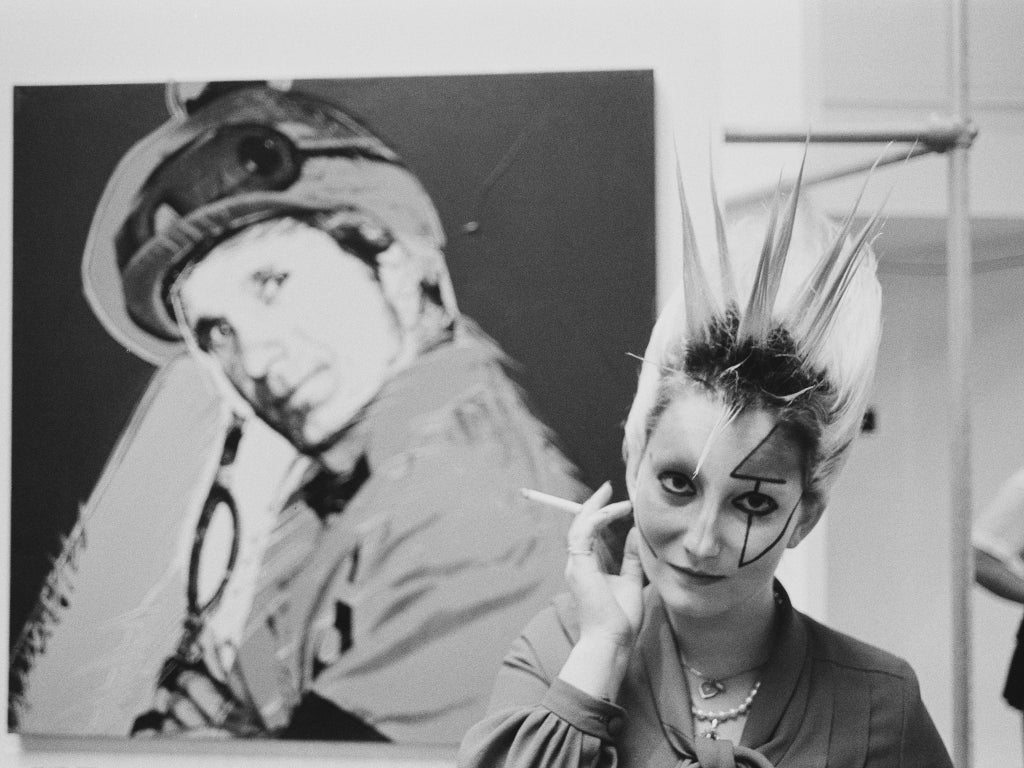
With her Mondrian-inspired make-up, outrageous hairstyles and shocking sartorial signature, Pamela Rooke, aka Jordan, described herself as “a walking work of art”. To the public, however, the fearless provocateur who travelled on the early morning train from the Sussex coast to central London in the mid-Seventies became the face of the most significant youth movement of modern times: punk.
Jordan’s eye-popping appearance, which took two hours a day to create, came from a deep desire to reinvent herself. Ricocheting between skintight latex rubber to translucent attire, often exposing breasts, buttocks and pubic hair, this innately shy girl affronted her fellow commuters. Describing their reaction decades later as “apoplectic” she was seated in a first-class carriage by British Rail staff for her own safety.
Jordan’s daily destination was 430 King’s Road. There she met Vivienne Westwood and Malcolm McLaren, where their shop Let It Rock was making the transition to SEX. It was a clear case of serendipity. The perfect visual accompaniment, Jordan was already into fetishwear and became their shop assistant. With a clientele that included sex workers, dominatrixes and the plain curious, McLaren’s dream was to see rubberwear in the office.
Jordan quickly became a source of fascination, garnering fans including Andy Warhol whom she met four times. “Warhol was disappointed when he met me,” recalls Westwood in her memoir, co-written with Ian Kelly, “because he thought I was Jordan or rather had seen pictures of Jordan and assumed that was me.”
Pamela Rooke was born in Seaford on 26 June 1955. Her father, Stanley James Rooke was originally from Tottenham. Her mother, Rosalind Jean Needham, was a professional seamstress from Islington. The fourth of four children, Jordan had a sister Jeannie, a brother Roger and another, Michael, who died at 18 months from scarlet fever.
In late May 1973, she had a life-changing experience when she saw David Bowie, appearing as Ziggy Stardust. By June she had left school and started nightclubbing, calling herself “Jipper” and frequenting underground gay bars including Tricky Dicky’s disco in Brighton, then Louise’s in London.
By 1977, the year when punk reached its crescendo, Jordan was at its centre. She had already witnessed firsthand the forming of the Sex Pistols. In their first TV appearance on So It Goes Jordan is seen dancing at the side with a peroxide beehive and swastika on her arm. Jordan was at the infamous boat party down the Thames where the police raided the Sex Pistols’ performance on jubilee night.

Reigniting her childhood dream to be a ballet dancer, in 1978 Jordan made an unforgettable appearance in Derek Jarman’s Jubilee, as both a ballerina and a character called Amyl Nitrate singing “Rule Britannia”. Three years later, on Jordan’s 26th birthday, she committed an unlikely conventional act when she married musician Kevin Mooney at Marylebone Registry Office wearing pieces from Westwood’s Pirate collection. The afterparty at artist Andrew Logan’s warehouse was filmed by Derek Jarman.
By 1984 Jordan, now divorced from Mooney, turned her back on London life and returned to Seaford to work as a veterinary nurse and be beside her family. “If I hadn’t moved back to Seaford when I did I might have missed out on my parents’ last years – and my mother’s end in 1987,” she writes in her autobiography Defying Gravity: Jordan’s Story. Her father lived to 91 years old.
Jordan rarely surfaced on the London scene after her relocation to Seaford. She attended the launch of Julien Temple’s film The Filth and the Fury in 2000 which Jordan described as “a moving re-evaluation of the madness of those heady days … it was the beginning of a massive renaissance of interest in punk from all quarters.”
The next reunion was Malcolm McLaren’s funeral in April 2010 where Jordan was invited by Vivienne Westwood’s son, Joe Corre. According to Jordan, punk had undergone a surprising transformation “becoming the subject of university courses, symposiums and huge retrospective exhibitions around the world”.
On 23 June 2015, at Kerry Taylor Auctions, Jordan sold her entire collection of clothes she acquired during the punk period and beyond. The most infamous piece, the Venus studded shirt, sold for £27,500 and now forms part of the fashion designer Kim Jones’s archive.
“Before the auction I spent about £3.75 renovating my clothes,” recalled Jordan. “It was spent on a J-Cloth, water – which I won’t count – and two pots of very cheap leather restorer. I didn’t dare wash anything.”
The auction, entitled “Passion for Fashion”, combined Jordan’s wardrobe with the Ossie Clark collections of Celia Birtwell, textile designer and muse of artist David Hockney. Birtwell had witnessed the Jordan effect in its heyday. “She was marvellous. The real thing. She was the star of it all. She was a very quiet person. A kind of hero of that movement. The epitome of punk.”
Jordan was, until her untimely death at the age of 66 from a rare form of cancer, one of the world’s true originals. “People always got confused with me as being brave,” she told musician and writer John Robb. “But for me it was normal and comfortable. Not one person tried to copy me which I find amazing.”
Pamela Rooke, model, actor and veterinary nurse, born 23 June 1955, died 3 April 2022







